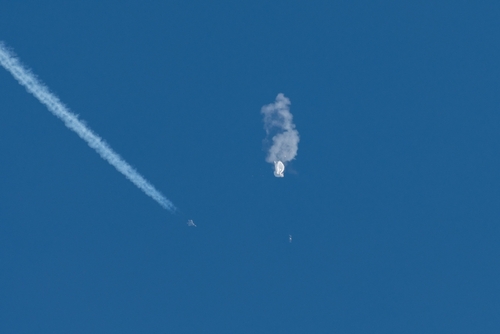
In a revelation that could recalibrate our understanding of unidentified flying objects, the recently retired chief of the Pentagon’s UFO division has shed light on the enigmatic ‘cube in a sphere’ sightings reported by Navy pilots. These incidents, which have puzzled military personnel and civilians alike, are now believed to be encounters with highly sophisticated drones.
Dr. Sean Kirkpatrick, who led the Pentagon’s efforts to investigate aerial phenomena, has suggested that these mysterious objects, witnessed near the Atlantic coast between 2014 and 2015, are likely ‘next generation’ drones. Their precise movements and advanced capabilities nearly resulted in a mid-air collision with an F/A-18 Super Hornet, demonstrating the potential risks such technology poses to national security.
It has been almost a year. I still have many outstanding questions about how the Chinese spy balloon traversed the continental United States. pic.twitter.com/TtAiFzsxpE
— Senator Roger Wicker (@SenatorWicker) January 22, 2024
The description provided by Dr. Kirkpatrick aligns with a drone prototype unveiled by Chinese researchers in 2022. This prototype, a silver orb equipped with eight thrusters positioned at the corners of an internal cube, is capable of executing maneuvers previously unseen in drone technology. While not explicitly confirmed, the similarities between the observed UFOs and this prototype raise questions about the origin and intent behind these aerial devices.
Dr. Kirkpatrick’s tenure at the Pentagon’s Aerial Anomaly Resolution Office (AARO) was marked by a pragmatic approach to the UFO phenomenon. He emphasized the importance of taking such sightings seriously, without succumbing to ridicule or dismissal. His focus on identifying terrestrial explanations for these encounters underscores the need for vigilance against technological surprises that could be exploited by adversaries.
The American people deserve to know if information about UFOs is being kept from the public and what it entails. When I’m president, I’ll disclose all information about UFOs to the public unless there’s a compelling reason not to do so. #Kennedy24 pic.twitter.com/DLN9lIiMoG
— Robert F. Kennedy Jr (@RobertKennedyJr) January 23, 2024
The former UFO chief’s perspective is grounded in a sobering reality: the potential for foreign entities to deploy advanced surveillance technology within U.S. airspace. The recent incident involving multiple objects tracked and shot down over North American skies echoes this concern. It highlights the necessity for the U.S. to remain alert and responsive to aerial threats, whether they originate from other nations or are developed domestically.
Critics of Dr. Kirkpatrick’s approach, including some within the UFO research community, have accused him of being overly dismissive of alternative explanations for these phenomena. However, his stance is rooted in a commitment to national security and the scientific method. By prioritizing empirical evidence and plausible hypotheses, he has sought to demystify the unknown and protect the nation from potential threats.
As the search for Dr. Kirkpatrick’s successor continues, the debate over how to handle UFO sightings rages on. Some advocate for greater openness and collaboration with civilian researchers, while others support a more guarded, security-focused approach. Regardless of the direction taken, it is clear that the issue of unidentified aerial phenomena remains a pressing concern for both national defense and public interest.
In conclusion, the insights provided by the Pentagon’s former UFO chief represent a significant step towards understanding the nature of the ‘cube in a sphere’ craft. As we grapple with the implications of these advanced drones, it is imperative that we maintain a balance between curiosity and caution, ensuring that our skies remain safe and our secrets secure.












